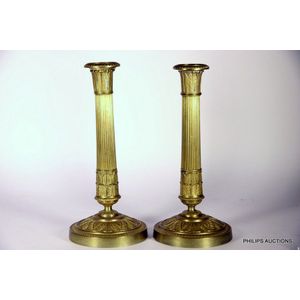Tiffany Favrile Glass Vase
You must be a subscriber, and be logged in to view price and dealer details.
Subscribe Now to view actual auction price for this item
When you subscribe, you have the option of setting the currency in which to display prices to $Au, $US, $NZ or Stg.
- Pontil Mark - A pontil mark, also known as a pontil scar, is a distinctive mark or scar found on the base of certain types of glass. It is a remnant of the glassblowing process and is particularly associated with handcrafted items made prior to the widespread use of automated manufacturing.
The pontil mark is created during the final stages of production. After the glassblower has shaped and formed the glass object, it is removed from the blowing iron. At this point, the glass object is often attached to a solid rod called a pontil rod or punty for further shaping, finishing, or attaching additional components. The attachment point is typically at the base of the object.
Once the glass item is complete, it is detached from the pontil rod, leaving behind a mark or scar on the base. This mark can take various forms, such as a rough or irregular surface, a concave or slightly recessed area, or a small circular scar. The presence of a pontil mark indicates that the item was handcrafted rather than mass-produced.
Collectors and historians often use pontil marks as clues to determine the age, authenticity, and production methods of glass or ceramic pieces. Different types of pontil marks may suggest different techniques used in the production process. For example, an open pontil mark is one where the scar is left as an exposed, roughened area, while a closed pontil mark occurs when the scar is smoothed or covered in some way. It's important to note that not all handcrafted glass items have pontil marks, as some artisans developed alternative methods for finishing their work. In Edwardian times the pontil mark was oftern ground off leaving a concave circle in the centre of the base of the object.
The use of pontil marks diminished with the advent of industrialization and automated manufacturing processes in the 19th and 20th centuries. - Favrile - Favrile glass is a type of iridescent art glass, similar to some of the Roman glass that has been excavated after being buried for centuries. It was developed by Louis Comfort Tiffany in 1892, patented in 1894 and the first itmes were produced in 1896. It differs from most iridescent glasses because the colour is ingrained in the glass itself, instead of being sprayed onto the surface while the glass was molten, as with Carnival glass.
The most common items manufactured by Tiffany in favrile glass were vases.
The glass was imitated by Loetz and other Bohemian manufacturers.
This item has been included into following indexes:
Visually similar items

A small rouge marble column, in the grand tour style, 19th century, 44.5 cm high

A mahogany circular column style pedestal 110 x 25 cm

Pair of sterling silver candlesticks, marked MCH, London, approx 16 cm high, (2)

A pair of Empire style brass pedestal candlesticks, late 19th century, France, elegant tapering ribbed pillar sticks with engine turning and stiff leaf borders to the capitals, lower register, and spreading bases, height 30 cm
